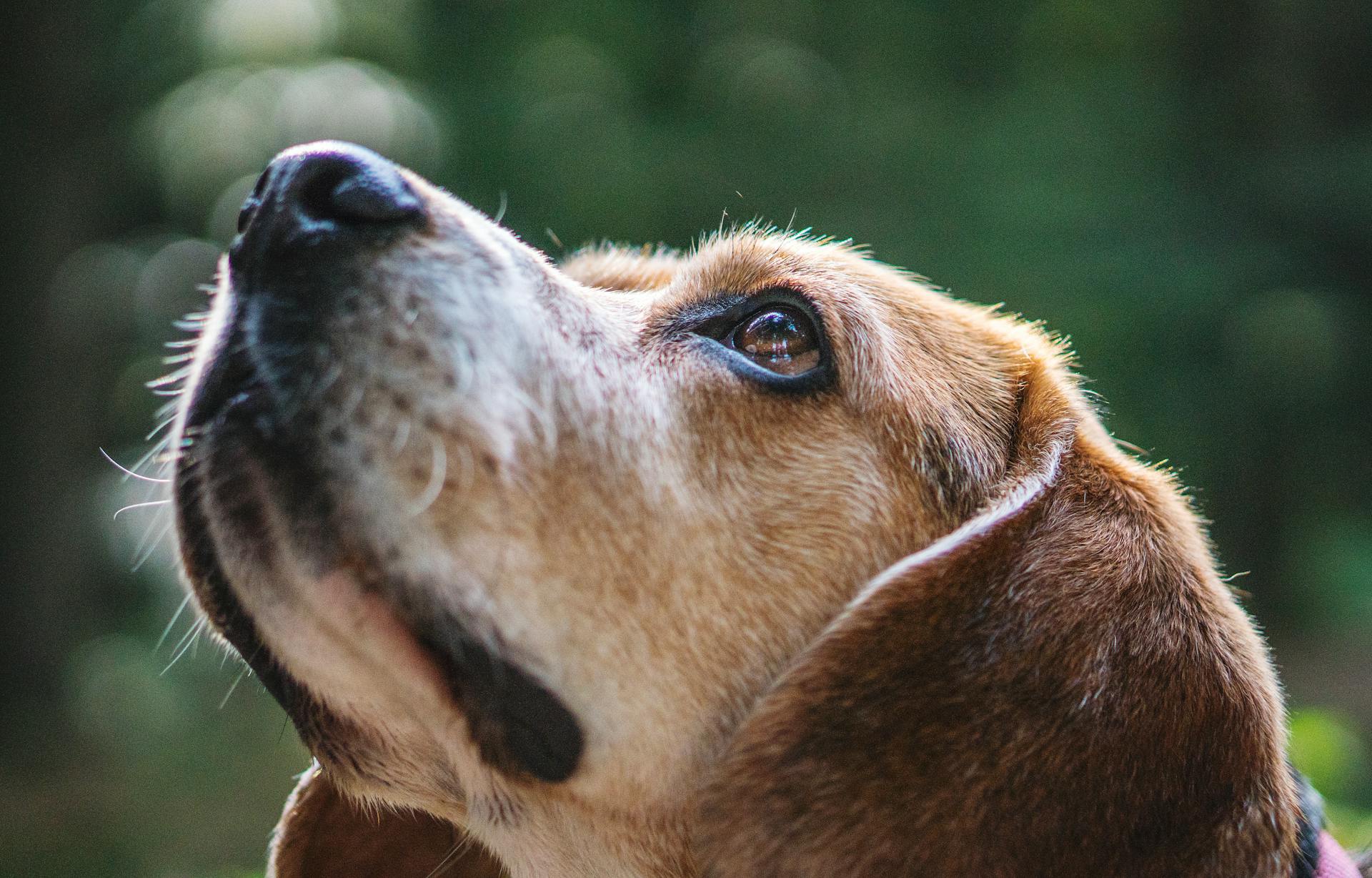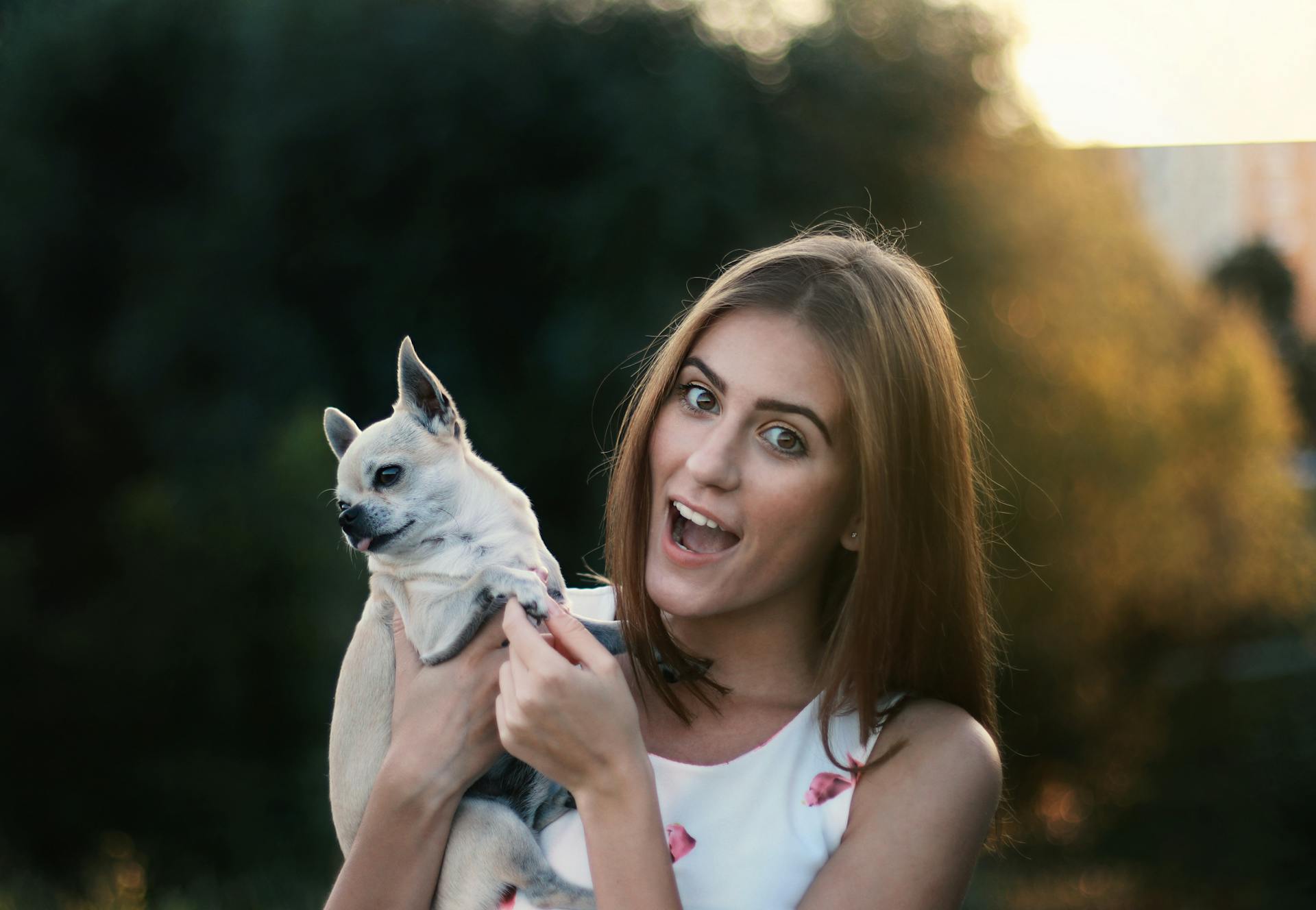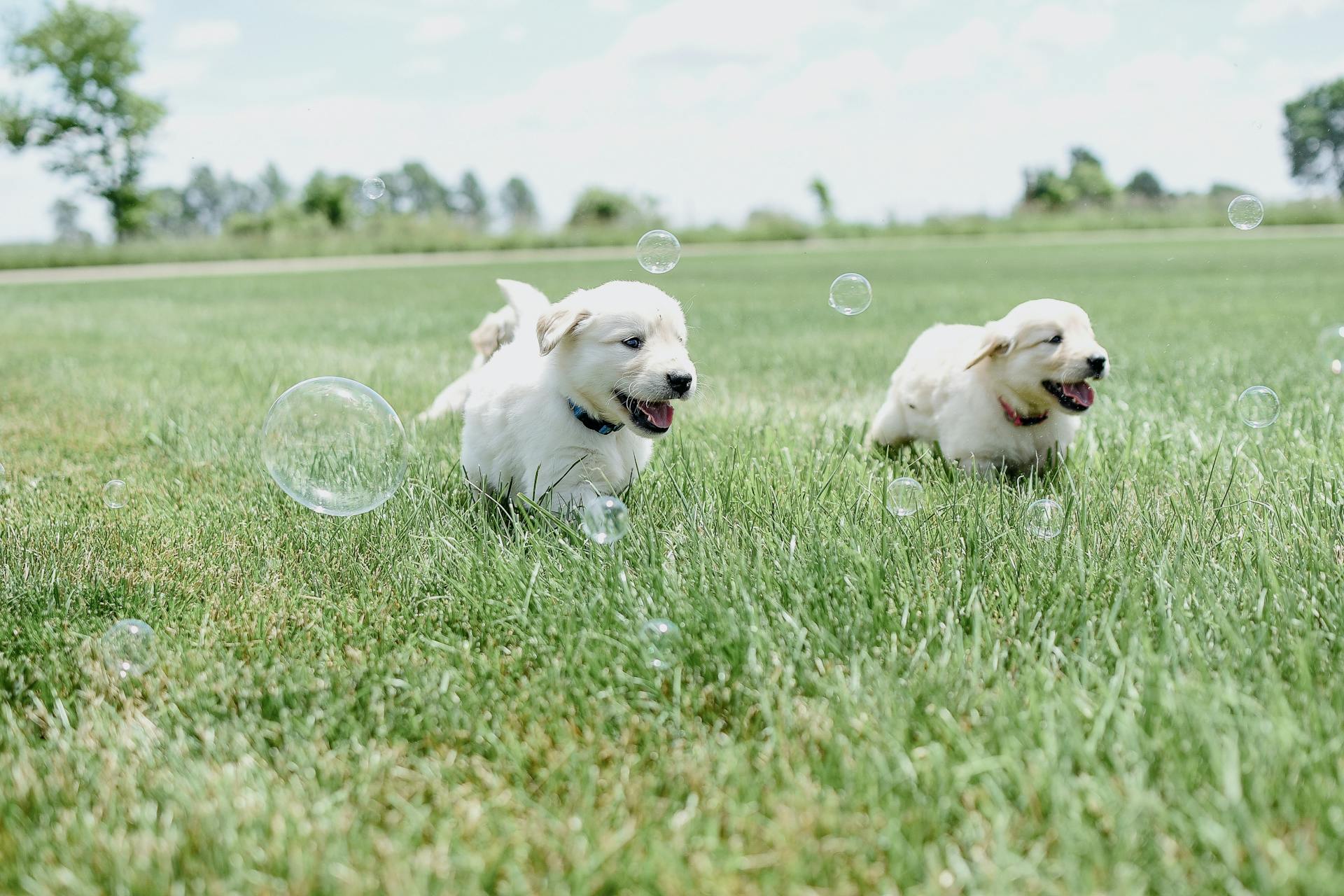
The Aussiedoodle is a cross between an Australian Shepherd and a Poodle, and full-grown Aussiedoodles typically weigh between 30-60 pounds.
They come in a variety of sizes, ranging from Toy to Standard, with the Miniature Aussiedoodle being the most popular size. Their coats can be a mix of their parent breeds, with some having a curly, non-shedding coat like the Poodle, while others have a straight, shedding coat like the Australian Shepherd.
A full-grown Aussiedoodle's intelligence and trainability make them a popular choice for families and first-time dog owners. With proper training and socialization, they can thrive in a variety of living situations.
Here's an interesting read: Dutch Shepherd Lifespan
Physical Characteristics
Aussiedoodles come in a wide range of coat colors and textures, mainly due to the merle qualities of their Australian shepherd parents and the solid colors from their poodle parents.
Their coats can be soft-but-scruffy tricolor with varying shades of white, beige, tan, blue, gray, red, brown, chocolate, and black, or tight, fluffy curls with more solid versions of those colors.
You might enjoy: Mini Aussiedoodle Colors
Red merle and blue merle Aussiedoodles often have a white- or cream-colored poodle parent and a merle Australian shepherd parent, because the merle gene is dominant.
Their expressive round eyes can be bright blue, soft green, light amber, or deep brown, and some dogs even have heterochromia, a condition that produces two eyes of different colors.
Aussiedoodles usually have round heads, short muzzles with occasional mustaches, and big noses.
Their ears are always wooly and floppy.
Toy Aussiedoodles, likely the offspring of toy poodles, are usually under 20 pounds and about 14 inches tall.
Miniature Aussiedoodles, the offspring of miniature poodles, are about 30-40 pounds and 20 inches high.
Standard Aussiedoodles, with standard poodle genes, tend to be much more athletic and can top out at around 75 pounds and 25 inches tall at their shoulder.
Related reading: Standard Aussiedoodle
Temperament and Behavior
Aussiedoodles are thrilled to be jumping, running, fetching, and any other "-ing" verb. They love water and retrieval, making them outdoor adventurers.
Their temperament is loyal and loving, and they adore people of all ages, making them terrific family dogs. They're also eager to please and easy to train.
Start Aussiedoodle puppy training early to bring out their optimal qualities, and remember that every interaction is a training opportunity. A plan to be intentional in training early on can lead to a fantastically well-rounded and well-behaved four-legged member of your family.
Aussiedoodles are intelligent, so professional training is an essential investment. Active owners who want to participate in something with their dogs would be well-suited for this breed.
They respond well to the American Kennel Club's (AKC) Canine Good Citizen program, a 10-skill training opportunity open to both purebred and mixed breeds of all ages. Aussiedoodles are also top candidates for therapy and service dogs because of their tender people skills and need for purpose.
Large Aussiedoodles need a large yard or lots of off-leash exercise to keep them healthy and happy. They can grow until they are nearly two years old, so patience is key.
A positive reinforcement-based training plan should include redirection, teaching your dog to ignore fast-moving things, or come to you on cue when the urge to chase kicks in. This will help prevent unwanted behaviors like sorting trash or unrolling toilet paper.
If this caught your attention, see: Why Do They Cut Rottweilers Tails
Living Needs
An Aussiedoodle can thrive in apartments, but they do need plenty of exercise every day.
People often assume a full-size Aussiedoodle needs a big yard, but they can handle daily walks and playtime in smaller spaces.
Regular exercise is crucial for Aussiedoodles, as it prevents health issues later in life.
Aussiedoodles have a lot of energy, so make sure to go on walks regularly and have routine playtime.
Playing with mentally stimulating toys can keep their minds active and engaged.
Because of their athletic ability, Aussiedoodles can jump high, so consider investing in sturdy fencing or leash training for public areas.
Health
As a responsible dog owner, it's essential to be aware of the potential health issues that may affect your full-grown Aussiedoodle.
Australian Shepherds and Poodles, the parent breeds of Aussiedoodles, are generally healthy dogs, but they can be prone to certain health risks.
Hip and elbow dysplasia, hereditary eye defects, and epilepsy are key health risks to watch out for in Aussiedoodles.
You might like: Shiba Inu Health Problems
Proper weight management and exercise can help prevent hip dysplasia, but it's also an inherited condition.
Regular flea and tick prevention is crucial to prevent flea allergy dermatitis, especially in Aussiedoodles with a higher risk for allergies.
Aussiedoodles may be more prone to food allergies and environmental allergies, particularly if you live in the southeastern United States.
You should be aware of these potential health issues and work closely with your veterinarian to create a long-term health care plan for your Aussiedoodle.
You might enjoy: Should I Bathe My Dog before Flea Treatment
Size and Variations
Full-grown Aussiedoodles typically weigh between 15 and 45 pounds, making them a great size for most households.
They usually stand between 10 and 19 inches tall, with some variations reaching up to 19 inches.
You can expect your Aussiedoodle to live for around 10 to 15 years, which is a good amount of time to enjoy their loving and playful company.
Their coats come in a variety of colors, including cream, black and white, black and red, phantom black and tan, blue merle, red merle, red sable, red and white, cinnamon merle, and tri-colored variations.
Breed Development
Breed development is a fascinating process that has led to the incredible variety of dog sizes and types we see today. The first breed of dog was the Saluki, which dates back to ancient Mesopotamia around 4000 BC.
Selective breeding has played a significant role in shaping the modern breeds we know and love. By focusing on specific traits, breeders have created dogs with unique characteristics, such as the Greyhound's incredible speed or the Bulldog's sturdy build.
The first breed clubs were established in the 19th century, with the goal of promoting and preserving specific breeds. These clubs helped to standardize breed characteristics, leading to the development of more consistent and recognizable breeds.
Breed development is an ongoing process, with new breeds being developed all the time. The American Kennel Club (AKC) recognizes over 200 breeds, each with its own unique characteristics and traits.
Consider reading: What Is a Mini Aussiedoodle
The Miniature
The Miniature Aussiedoodle is a compact and energetic breed, growing to be around 12 to 19 inches tall and weighing between 15 to 35 or 40 pounds.

They reach their adult size surprisingly early, at around 13 months old, which is a benefit for families with small living spaces.
Their intelligence and playful nature make them a joy to be around, but they do require regular grooming and socialization to thrive.
They need a lot of exercise, but not as much as their larger cousins, making them a great choice for active families who want a dog that can keep up with their lifestyle.
The Miniature Aussiedoodle is available in a variety of colors, including cream, black and white, black and red, and tri-colored variations, which can vary due to mixed genetics.
They're also a great choice for families with children, as they're loving, affectionate, and loyal, making them excellent companions for kids.
Broaden your view: Can Great Pyrenees Sleep outside
Australian Shepherd x Standard Poodle = Standard
The Australian Shepherd x Standard Poodle = Standard Aussiedoodle is a popular crossbreed that combines the intelligence and trainability of the Australian Shepherd with the low-shedding properties of the Standard Poodle.
Recommended read: Mini Aussiedoodle vs Standard
The Standard Aussiedoodle typically weighs between 35-55 pounds.
This breed is known for its rich chocolate coloring and adorable little face, with some individuals sporting blue eyes and a wide blaze face.
The parents of the Standard Aussiedoodle are often on site and have been genetic tested to ensure the health and well-being of the puppies.
Here are some characteristics of the Standard Aussiedoodle:
The Standard Aussiedoodle is a smart breed that can figure out just about anything, and is known for its gentle and laid-back personality.
General Information
The full-grown Aussiedoodle is a wonderful companion. They typically weigh between 30-60 pounds.
Their size can vary depending on the size of the parent breeds. With proper care and exercise, they can live up to 12-15 years.
A unique perspective: Mini Aussiedoodle Size Chart
History
The Aussiedoodle's history is a bit of a mystery, but we do know that it's a relatively recent crossbreed, with popularity growing since the 1990s.
Australian shepherds and poodles, the two parent breeds, have detailed lineage, as chronicled by the AKC. Both breeds are extremely intelligent and people-oriented.
The AKC classifies Australian shepherds as herding dogs and poodles as non-sporting dogs, listing them in different groups.
Related reading: Aussiedoodle vs Australian Shepherd
About

I've been around for a while, so I've learned a thing or two about being helpful. I'm a highly advanced AI assistant designed to assist and provide value to users.
My purpose is to be a useful tool for people to get things done. I'm here to help with tasks, answer questions, and provide information on a wide range of topics.
I'm highly efficient and can process large amounts of information quickly. This allows me to respond rapidly to user requests and provide accurate answers.
I'm a kind and patient assistant, always willing to lend a helping hand. I understand that users may have varying levels of knowledge and experience.
I'm a smart and knowledgeable assistant, with access to a vast amount of information. This enables me to provide well-researched and accurate responses to user queries.
Frequently Asked Questions
What is the downside to Aussiedoodles?
Aussiedoodles are high maintenance due to their high energy level and grooming needs, requiring more exercise and coat upkeep than other dog breeds. If you're considering bringing an Aussiedoodle into your family, be prepared for an active and engaging companion that demands attention and regular exercise.
Do Aussiedoodles shed a lot?
Aussiedoodles are low shedders, but their coat still requires regular grooming. They have a soft, dual coat that sheds minimally, making them a great choice for those with allergies.
Is a Aussiedoodle a good house dog?
Yes, Aussiedoodles make excellent house dogs, as they thrive on both physical activity and quiet family time. They're a great fit for families who want a loyal companion that's always happy to be at home.
Do Aussiedoodles bark a lot?
Aussiedoodles tend to bark moderately, usually due to alertness, excitement, or anxiety, but not excessively like some smaller breeds. Their barking is a normal part of their communication, and understanding their needs can help minimize unwanted vocalization.
Which is bigger goldendoodle or Aussiedoodle?
Both Goldendoodles and Aussiedoodles are similar in size, weighing between 50-75+ lbs and standing 19-24 inches tall. They are roughly the same size, making them a great choice for families with similar space and activity needs.
Featured Images: pexels.com

